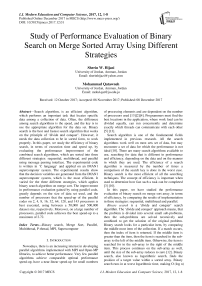Study of performance evaluation of binary search on merge sorted array using different strategies
Автор: Sherin W. Hijazi, Mohammad Qatawneh
Журнал: International Journal of Modern Education and Computer Science @ijmecs
Статья в выпуске: 12 vol.9, 2017 года.
Бесплатный доступ
Search algorithm, is an efficient algorithm, which performs an important task that locates specific data among a collection of data. Often, the difference among search algorithms is the speed, and the key is to use the appropriate algorithm for the data set. Binary search is the best and fastest search algorithm that works on the principle of ‘divide and conquer’. However, it needs the data collection to be in sorted form, to work properly. In this paper, we study the efficiency of binary search, in terms of execution time and speed up, by evaluating the performance improvement of the combined search algorithms, which are sorted into three different strategies: sequential, multithread, and parallel using message passing interface. The experimental code is written in ‘C language’ and applied on an IMAN1 supercomputer system. The experimental results show that the decision variables are generated from the IMAN1 supercomputer system, which is the most efficient. It varied for the three different strategies, which applies binary search algorithm on merge sort. The improvement in performance evaluation gained by using parallel code, greatly depends on the size of data set used, and the number of processors that the speed-up of the parallel codes on 2, 4, 8, 16, 32, 64, 128, and 143 processors is best executed, using between a 50,000 and 500,000 dataset size, respectively. Moreover, on a large number of processors, parallel code achieves the best speed-up to a maximum of 2.72.
Binary search, Merge Sort, Parallel, Multithread, P-thread, MPI, Supercomputer
Короткий адрес: https://sciup.org/15016717
IDR: 15016717 | DOI: 10.5815/ijmecs.2017.12.01
Текст научной статьи Study of performance evaluation of binary search on merge sorted array using different strategies
Nowadays, there is an increasing interest in developing parallel algorithms implemented with MPI and Open-MP libraries, to achieve better performance. Very few parallel algorithms achieve comparable optimal performance speed-up, have a near-linear speed-up for small numbers of processing elements and are dependent on the number of processors used [13][2][4]. Programmers must find the best locations in the application, where work load can be divided equally, can run concurrently and determine exactly which threads can communicate with each other [5] [13].
Search algorithm is one of the fundamental fields implemented in previous research. All the search algorithms work well on most sets set of data, but may encounter a set of data for which the performance is not ideal [10]. There are many search algorithms available to use, searching for data that is different in performance and efficiency, depending on the data and on the manner in which they are used. The efficiency of a search algorithm is measured by the number of times a comparison of the search key is done in the worst case. Binary search is the most efficient of all the searching techniques. The concept of efficiency is important when used to determine how fast such a task can be completed [3] [10].
In this paper, we have studied the performance evaluation of binary search on merge sort array, in terms of efficiency, by comparing the results of implementation in three strategies: sequential, multithread and parallel.
Binary search is a ‘divide and conquer’ search algorithm. The ‘divide and conquer’ approach means, that the problem is divided into several small sub-problems, then the sub-problems are solved recursively and combined to get the solution of the original problem. Binary search looks for a particular item, by comparing the middle most item of the collection. If a match occurs, then the index of item is returned. If the middle item is greater than the item, then the item is searched in the subarray to the left of the middle item. Otherwise, the item is searched for in the sub-array to the right of the middle item. This process continues on the sub-array as well, until the size of the sub-array reduces to zero [12]. Binary search, also known as logarithmic search, finds the position of a target value within a sorted array. Binary search runs in at worst logarithmic time, making O (log n)
comparisons, where n is the number of elements in the array [21].
Merge sort is a ‘divide and conquer’ sorting algorithm. In merge sort, there are a series of three steps: divide, conquer and combine. Initially divide the given array consisting of n elements into two parts of n/2 elements each. Sort the left part and right part of the array recursively. Merge the sorted left part and right part to get a single sorted array [6][7][8][9]. Merge sort runs in at worst logarithmic time, making O (n log n) [22]. Fig. 1 shows the sequential merge sort consisting of an array of 4 elements to be sorted. Merge sort in sequential, is based on the fact that the recursive calls run in serial, with the time complexity (1):
T(n) = Θ (n log (n)) + Θ (n) = Θ (n log (n)) (1)
Multithread merge sort , creates thread recursively, and stops work when it reaches a certain size, with each thread locally sorting its data. Then threads merge their data by joining threads into a sorted main list. Fig. 2 shows the multithread merge sort that have array of 4 elements to be sorted. Merge sort in multithread is based on the fact that the recursive calls run in parallel, so there is only one n/2 term with the time complexity (2):
T(n) = Θ log(n) + Θ(n) = Θ(n) (2)
A thread is a stream of instructions that can be scheduled as an independent unit. A thread exists within a process, and uses the process resources, since threads are very small compared with processes. Multithreaded programs may have several threads running through different code paths "simultaneously" [11][14][24]. P-thread library is an execution model of (a POSIX C API) that has standardized functions for using threads across different platforms. P-threads are defined as a set of ‘C language’ programming types and procedure calls. . It allows a program to control multiple different flows of work that overlap in time. Each flow of work’s creation and control over these flows is achieved by making calls to the POSIX Threads API [24].
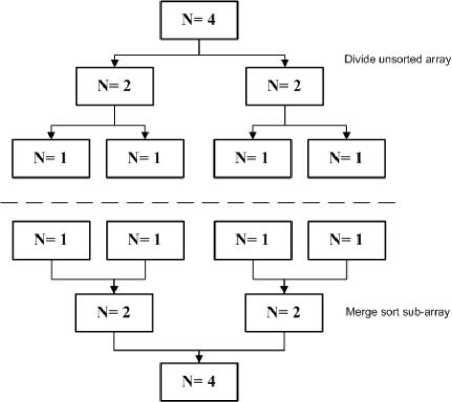
Fig.1. Sequential Merge Sort
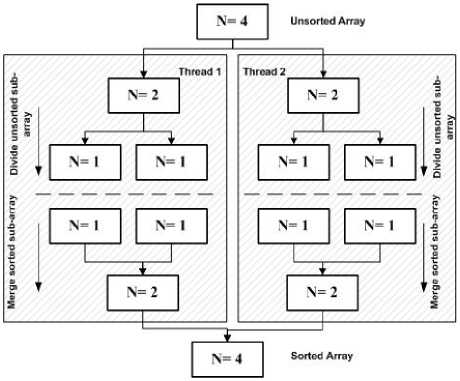
Fig.2. Multithread Merge Sort
Parallel merge sort , is repeatedly split into a main array of parts, having the same size, and each part is processed by a separate processor to the point of having single-element lists. These elements are then merged together to generate sorted sub-lists. One of the parallel processes is designated as a master. This process distributes the data parts among other worker’s parallel processes that use the sequential version of merge sort, to sort their own data. Then sorted sub-lists are sent to the master. Finally, the master merges all the sorted sub-lists into one sorted list [1] [23]. Merge sort in parallel, is based on the fact that the recursive calls run locally on each processor, so there is only one n/p term with the time complexity (3) [6]:
T(n) = O ((n/p) * log(n/p)) + O(n) (3)
Message Passing Interface (MPI) is widely used to implement parallel programs [1]. MPI standard has been designed to enhance and reduce the gap between the performance by a parallel architecture and the actual performance [1] [21][22]. MPI offers several functions, including send/receive operations. There are also several implementations used in writing MPI programs, one of which is parallel virtual machine. Parallel Virtual Machine (PVM), is a software package that permits a heterogeneous collection of UNIX or Windows computers, hooked together by a network, to be used as a single large parallel computer [1][23][24].
Combining both binary search and merge sort algorithms, using function methods. In this paper the algorithm is created with three different strategies, using a generated random array dataset: sequential, multithread and parallel. A sequential code, executing on a single processor can only perform one computation at a time. Whereas the multithread and parallel code is executed in parallel and divide up perfectly among the multi-thread and multi-processors. The main objective of this algorithm is to study and evaluate the performance execution time and speed up.
The results were conducted using IMAN1 supercomputer [20] which is Jordan's first and fastest supercomputer. It is available for use by academia and industry in Jordan and the region and provides multiple resources and clusters to run and test High Performance Computing (HPC) codes.
The remainder of the paper is organized as follows: Section 2 presents related work. Section 3 presents experimental and result evaluation. Section 4 presents conclusion and future work.
-
II. Related Work
There has been little work done to parallelize the search algorithms, using different strategies and parallel architectures. In [10] the author’s study is an evaluation of critical factors affecting the efficiency of searching techniques. They conclude that numbers of comparisons is the most critical factor affecting the searching techniques. They also show that binary search is the most efficient of all searching techniques.
With reference to [6] the author’s studies of performance evaluation of parallel quicksort, parallel merge sort, and parallel merge-quicksort algorithms in terms of running time, speedup, and efficiency using open MPI library and the experiments conducted used IMAN1 supercomputer, findings were as follows: Parallel Quicksort has better running time for both small and large data size, followed by Merge-Quicksort and then Merge sort algorithms.
“Ref. [15]”, the author’s has proposed work comparison of both single and multicore implementation of number searching and sorting for a large database. The results presented show that the multicores achieve better speed up over single core. Multi-core reduced the time for executed multiple threads in parallel.
-
III. Experimental and Evaluation Results
We have implemented binary search algorithm in three different scenarios: sequential code, multithread code and parallel code, for binary search using merge sort and random array dataset. We used IMAN1 supercomputer to prepare experimentation to evaluate performance execution time and speed up. The experiments were conducted on different data set sizes, to find out the best execution time and efficient results. First, the sequential code was executed and the time taken for three positions: generate random array, sort the random array, and search the item on sorted array. Second, the multithread code was executed and the time taken for about the same positions of sequential code which can be divided into threads using p-thread compiler. Third, the parallel code task was divided into sequential code segments, using an MPI compiler, which each segment runs on, with an individual processor. Then we calculated the execution time in each scenario of algorithm, to evaluate efficiency and determine which one has the best performance execution time and speed-up in different scenarios.
-
A. IMAN1 Supercomputer
IMAN1 is first Jordan's national supercomputer project started in January 2010. IMAN1 system is the fastest high performance computing resource, funded by JAEC and SESAME and it completely developed in house by Jordanian resources. IMAN1 is using in academic and industry in Jordan and region [16]. IMAN1 using 2260 PlayStation3 devices which have performance of 25 Tera FLOPS (25 x 1012 Flops i.e. 25 Trillion Floating Point Operations Per Second) [20].
-
B. Design Code and Implementation
The experiment was done by IMAN1 supercomputer center. We did our project in three scenarios. First, we combined both binary search and merge sort in sequential code. Then we implemented both binary search and merge sort with a multithread method. Finally, we implemented both binary search and merge sort, under parallel method, using an MPI compiler. The sequential, multithread and the parallel codes are explained below.
Sequential Code
Main function() with (stdio.h, stdlib.h and time.h) and define the size of array:
Step 1: Declare functions and variables to store allocated memory.
Step 2: Start the timer. clock_t start = clock();
Step 3: Declare srand to fill array with random numbers.
Step 4: Partition and divide unsorted array into subarray.
Step 4: Sort and merge the subarray into sorted array.
Step 5: Print sorted array.
Step 6: Find item within sorted array by use binary search, and then print if found item successful or not with position of item.
Step 7: End the timer. clock_t stop = clock();
Step 8: Calculate the difference in start and end time. diff = ( end – start ) *1000 / CLOCKS_PER_SECOND;
Step 9: Return 0.
Multithread Code
Main function() with (stdio.h, pthread.h, stdlib.h and time.h) and define: (size of array, number of thread and struct node)
Step 1: Declare functions and variables to store allocated memory.
Step 2: Start the timer. clock_t start = clock();
Step 3: Fill array with random numbers.
Step 4: Define node and create threads for partition and divide unsorted array.
Step 5: Join thread to sort and merge the subarray into sorted array.
Step 6: Print sorted array.
Step 7: Find item within sorted array by use binary search, and then print if found item successful or not with position of item.
Step 8: End the timer. clock_t stop = clock();
Step 9: Calculate the difference in start and end time. diff = ( end – start ) *1000 / CLOCKS_PER_SECOND;
Step 10: Return 0.
Parallel Code
Main function() with (stdio.h, mpi.h, stdlib.h and time.h) and define the size of array:
Step 1: Declare functions and variables to store allocated memory.
Step 2: Start the timer. clock_t start = clock();
Step 3: Create and populate the array by fill array with random numbers.
Step 4: Initialize MPI.
Step 5: Divide the unsorted array in equal-sized chunks.
Step 6: Send each subarray to each process.
Step 7: Perform the merge sort on each process.
Step 8: Gather the sorted subarrays into one.
Step 9: Make the final merge sort call.
Step 10: Print the sorted array
Step 11: Find item within sorted array by use binary search, and then print if found item successful or not with position of item.
Step 12: End the timer. clock_t stop = clock();
Step 13: Calculate the difference in start and end time. diff = ( end – start ) *1000 / CLOCKS_PER_SECOND;
Step 14: Clean up root.
Step 15: Clean up rest.
Step 16: Finalize MPI.
-
C. Performance Evaluation and Results
Table 1, shows software and hardware requirements and table 2 shows algorithms and the parameters used:
Run Time Evaluation
Tables 3, 4, 6, 7, and 8 show running time test code for each strategy to different dataset size. All results are performed on: 2, 4, 8, 16, 32, 64, 128, 143 processors. As illustrated in the tables, as the data size increases, the run time increases too, due to the increased number of comparisons and the increased time required for data splitting and gathering in a parallel strategy. Sequential code has the best run time for small dataset, while parallel code is the best in large dataset size, followed by sequential code and then multithread code. Finally, multithread code has the worst run time results.
Table 3. Test Data Set Size (489)
|
Sequential Algorithm |
Multithread Algorithm |
Parallel Algorithm |
|||
|
Run Time (MS) |
Up to |
Run Time (MS) |
Up to |
Run Time (MS) |
Processor |
|
0 |
1 |
1120 |
2 Thread |
30 |
2 |
|
50 |
4 |
||||
|
120 |
8 |
||||
|
130 |
16 |
||||
|
250 |
32 |
||||
|
130 |
64 |
||||
|
220 |
128 |
||||
|
200 |
143 |
||||
From table 3 shows that the sequential code has better running time in a small dataset, followed by parallel code and then multithread code.
Table 1. Software and Hardware Requirements
|
Software and Hardware |
Type |
|
Virtual tools |
Oracle VM VirtualBox and IMAN1 system |
|
Operating System |
Windows 10 64-bit and Linux 6.4 |
|
Languages |
C Language |
|
Hardware |
IMAN1 Supercomputer center |
|
Specification |
Intel core(TM) i7-4720HQ CPU 2.6GHz 16GB |
|
Library interface |
stdio, stdlib, time, pthread, and mpi |
Table 2. Algorithms and Parameters are used
|
Parameter |
Type |
|
Algorithms |
Binary search and merge sort |
|
Size of data set |
489, 10000, 50000, 250000, 500000 and 1000000 |
|
Number of processor |
1, 2, 4, 8, 16, 32, 64, 128 and 143 |
|
Strategy of scenario |
Sequential, multithreaded, and parallel |
|
Array dataset |
Random number generation |
|
Measurement |
Execution time and speed up |
Table 4. Test Data Set Size (10,000)
|
Sequential Algorithm |
Multithread Algorithm |
Parallel Algorithm |
|||
|
Run Time (MS) |
Up to |
Run Time (MS) |
Up to |
Run Time (MS) |
Processor |
|
10 |
1 |
Unable to create thread |
2 Thread |
0 |
2 |
|
60 |
4 |
||||
|
150 |
8 |
||||
|
70 |
16 |
||||
|
130 |
32 |
||||
|
70 |
64 |
||||
|
300 |
128 |
||||
|
130 |
143 |
||||
From table 4 shows that the parallel code at two processors has better running time at 10,000 elements, followed by sequential. However, in this case the multithread code could not create threads.
Table 5. Test Data Set Size (50,000)
|
Sequential Algorithm |
Multithread Algorithm |
Parallel Algorithm |
|||
|
Run Time (MS) |
Up to |
Run Time (MS) |
Up to |
Run Time (MS) |
Processor |
|
80 |
1 |
Unable to create thread |
2 Thread |
120 |
2 |
|
40 |
4 |
||||
|
120 |
8 |
||||
|
220 |
16 |
||||
|
220 |
32 |
||||
|
180 |
64 |
||||
|
240 |
128 |
||||
|
280 |
143 |
||||
Table 7. Test Data Set Size (500,000)
|
Sequential Algorithm |
Multithread Algorithm |
Parallel Algorithm |
|||
|
Run Time (MS) |
Up to |
Run Time (MS) |
Up to |
Run Time (MS) |
Processor |
|
910 |
1 |
Unable to create thread |
2 Thread |
470 |
2 |
|
560 |
4 |
||||
|
420 |
8 |
||||
|
580 |
16 |
||||
|
530 |
32 |
||||
|
770 |
64 |
||||
|
760 |
128 |
||||
|
800 |
143 |
||||
From table 5 shows that the parallel code at four processors has optimal running time at 50,000 elements, followed by sequential, also, in this case the multithread code could not create threads.
Table 6. Test Data Set Size (250,000)
|
Sequential Algorithm |
Multithread Algorithm |
Parallel Algorithm |
|||
|
Run Time (MS) |
Up to |
Run Time (MS) |
Up to |
Run Time (MS) |
Processor |
|
490 |
1 |
Unable to create thread |
2 Thread |
180 |
2 |
|
180 |
4 |
||||
|
280 |
8 |
||||
|
340 |
16 |
||||
|
360 |
32 |
||||
|
350 |
64 |
||||
|
610 |
128 |
||||
|
390 |
143 |
||||
Table 6 shows that the parallel code at two and four processors, has optimal running time at 250,000 elements, and has better running time up to 143 processors compared with sequential, except the case of 128 processors; again, in this case the multithread code could not create threads.
Table 7 shows that the parallel code at 8 processors has optimal running time at 500,000 elements, and has better running time at up to 143 processors compared with sequential, but there exist some differences in running time among processors, due to the delay of entire communication of functions and remote connection network.
Table 8. Test Data Set Size (1000,000)
|
Sequential Algorithm |
Multithread Algorithm |
Parallel Algorithm |
|||
|
Run Time (MS) |
Up to |
Run Time (MS) |
Up to |
Run Time (MS) |
Processor |
|
1870 |
1 |
Unable to create thread |
2 Thread |
760 |
2 |
|
750 |
4 |
||||
|
920 |
8 |
||||
|
1070 |
16 |
||||
|
1230 |
32 |
||||
|
1260 |
64 |
||||
|
1280 |
128 |
||||
|
1580 |
143 |
||||
Table 8 shows the parallel code at 4 processors has optimal running time at 1000,000 elements, and has better running time up to 143 processors compared with sequential, but there exists some differences in running time among processors, due to the delay of entire communication of functions and remote connection network.
Table 9 shows comparisons of optimal running time between sequential and parallel code. Table 3.10 shows a comparison of the optimal number of processors, with growth of dataset size.
Fig. 3 illustrates the run time, according to different dataset sizes in both sequential and parallel algorithms, the general behavior for two algorithms as the size of dataset increases that run time is increased in both algorithms, but that the parallel has the best run time results, due to better load distribution among more processors.
Table 9. Sequential and Parallel Running Time Comparison
|
Dataset Size |
Sequential Algorithm |
Parallel Algorithm |
|
Run Time (MS) |
Optimal Run Time (MS) |
|
|
489 |
0 |
30 |
|
10,000 |
10 |
0 |
|
50,000 |
80 |
40 |
|
250,000 |
490 |
180 |
|
500,000 |
910 |
420 |
|
1000,000 |
1870 |
750 |
Table 10. Number of Processors with Dataset Size
|
Dataset Size |
Optimal Number of Processor |
|
489 |
2 |
|
10,000 |
2 |
|
50,000 |
4 |
|
250,000 |
4 |
|
500,000 |
8 |
|
1000,000 |
4 |
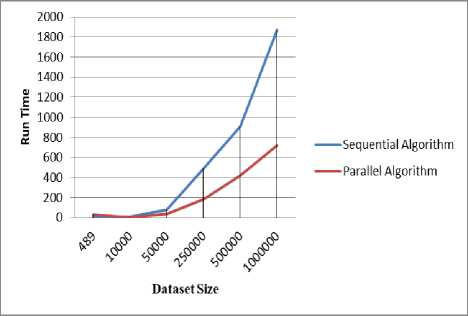
Fig.3. Sequential and Parallel Running Time Comparison
Speed up Evaluation
The speed-up is the ratio between the sequential time and the parallel time [6]. Table 11 and Fig. 4 illustrate the speed-up of the parallel code on 2, 4, 8, 16, 32, 64, 128 and 143 processors with 50,000, 250,000, 500,000 and million dataset sizes, respectively. The results show that parallel code achieves the best speedups values, up to 2.72. The speed-up defined as equation (4):
Speed up =
Run time using sequential code Execution time using a parallel with p processors
Table 11. Speed up of Different Datasets with Different Number of Processors
|
No. of Processor |
Speed up of 50,000 |
Speed up of 250,000 |
Speed up of 500,000 |
Speed up of 1000,000 |
|
2 |
0.67 |
2.72 |
1.94 |
2.46 |
|
4 |
2.00 |
2.72 |
1.63 |
2.49 |
|
8 |
0.67 |
1.75 |
2.17 |
2.03 |
|
16 |
0.36 |
1.44 |
1.57 |
1.75 |
|
32 |
0.36 |
1.36 |
1.72 |
1.52 |
|
64 |
0.44 |
1.40 |
1.18 |
1.48 |
|
128 |
0.33 |
0.80 |
1.20 |
1.46 |
|
143 |
0.29 |
1.26 |
1.14 |
1.18 |
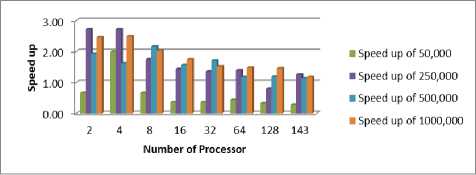
Fig. 4. Speed up of Different datasets with Different Number of Processors
From fig. 4 illustrate the speedup of the parallel codes on 2, 4, 8, 16, 32, 64, 128, and 143 processors is the best done between 50000 and 500000 dataset size, respectively.
-
IV. Conclusions
We conduct binary search on merge sort experimental by three different strategies: sequential, multithread and parallel on IMAN1 supercomputer. The results obtained from the experimental analysis performance execution time and speed up, the combine binary search and merge sort algorithms with parallel code performs better than the sequential and multithread code after 489 elements, followed by sequential and then multithread. As the array size becomes large then the number of processor increase. Multithread code used p-thread, but parallel written with MPI library. Moreover, the speedup of the parallel codes on 2, 4, 8, 16, 32, 64, 128, and 143 processors is up to 2.72, and the best is done between 50000 and 500000 dataset sizes, respectively. The future of this work seeks to use binary search on other sorting algorithms to evaluate performance in terms of execution time and speed up. And use other methods with multithread code such as MPI library.
Acknowledgment
We would like to acknowledge eng. Zaid Abudayyeh for his support to accomplish this work.
Список литературы Study of performance evaluation of binary search on merge sorted array using different strategies
- A. El-Nashar. “2011”. Parallel Performance of MPI Sorting Algorithms On Dual–Core Processor Windows-Based Systems. International Journal of Distributed and Parallel Systems (IJDPS) Vol.2, No.3, May 2011
- A. Madsen, F. Jensen, A. Salmeron, H. Langseth and Th. Nielsen. “2017”. A parallel algorithm for Bayesian network structure learning from large data sets. Knowledge base system, 117(2017) 46-55 Elsevier.
- A. Singh, Monika, Vandana and S. Kaur. “2011”. Assortment of Different Sorting Algorithms. Asian Journal of Computer Science and Information Technology, ISSN 2249- 5126.
- D. Penas, P. Gonzalez, J. Egea, J. Banga and R. Doallo. “2015”. Parallel metaheuristics in computational biology: an asynchronous cooperative enhanced Scatter Search method. ICCS 2015 International Conference On Computational Science, Volume 51, 2015, Pages 630-639, Elsevier.
- M. Geiger. “2017”. A multithread local search algorithm and computer implementation for the multimode, resource- constrained multi-project scheduling problem. European Journal of Operation Research. 0377-2217/@ 2016 Elesvier B.V.
- M. Saadeh, H. Saadeh and M. Qatawneh. “2016”. Performance Evaluation of Parallel Sorting Algorithms on IMAN1 Supercomputer. International Journal of Advanced Science and Technology Vol.95 (2016), pp.57-72
- M. Dawra, and Priti. “2012”. Parallel Implementation of Sorting Algorithms. IJCSI International Journal of Computer Science Issues, Vol. 9, Issue 4, No 3, July 2012 ISSN (Online): 1694-0814.
- M Rajasekhara Babu, M Khalid, Sachin Soni, Sunil Chowdari Babu, Mahesh. “2011”. Performance Analysis of Counting Sort Algorithm using various Parallel Programming Models. International Journal of Computer Science and Information Technologies, Vol. 2 (5) , 2011, 2284-2287.
- Mustafa B. and Waseem Ahmed. Parallel Algorithm Performance Analysis using OpenMP for Multicore Machines. International Journal of Advanced Computer Technology (IJACT), VOLUME 4, NUMBER 5, ISSN:2319-7900.
- Olabiyisi S.O, Aladesae T.S. , Oyeyinka F.I. , and Oladipo Oluwasegun. “2013”. Evaluation of Critical Factors Affecting The Efficiency of Searching Techniques. International Journal of Advanced Research in Computer Science and Software Engineering, Volume 3, Issue 7, July 2013, ISSN: 2277 128X.
- P. Kulkarni and S. Pathare. “2014”. Performance Analysis of Parallel Algorithm over Sequential using OpenMP. IOSR Journal of Computer Engineering (IOSR-JCE) e-ISSN: 2278-0661, p- ISSN: 2278-8727Volume 16, Issue 2, Ver. X (Mar-Apr. 2014), PP 58-62.
- R. Banos, J. Ortega, C. Gil, F. de Toro and M. Montoya. “2016”. Analysis of OpenMP andMPI implementations of meta-heuristics for vehicle routing problems. Applied Soft Computing, 1568-4946/@2016 Elesvier B.V.
- Sh. Kathavate1 and N.K. Srinath. “2014”. Efficiency of Parallel Algorithms on Multi Core Systems Using OpenMP. International Journal of Advanced Research in Computer and Communication Engineering Vol. 3, Issue 10, October 2014.
- S. K. Sharma and K. Gupta. “2012”. Performance Analysis of Parallel Algorithms on Multi-core System using OpenMP. International Journal of Computer Science, Engineering and Information Technology (IJCSEIT), Vol.2, No.5, October 2012.
- Venkata Siva Prasad Ch., Ravi S. and Karthikeyan V. “2015”. Performance Improvement in Data Searching and Sorting Using Multi-Core. ARPN Journal of Engineering and Applied Sciences, VOL. 10, NO. 16, SEPTEMBER 2015, ISSN 1819-6608.
- Azzam Sleit, Wesam AlMobaideen, Mohammad Qatawneh, Heba Saadeh.”2008”. Efficient Processing for Binary Submatrix Matching. American Journal of Applied Sciences 6 (1): 78-88, 2008, ISSN 1546-9239.
- Mohammad Qatawneh, Azzam Sleit, Wesam Almobaideen. “2009”. Parallel Implementation of Polygon Clipping Using Transputer. American Journal of Applied Sciences 6 (2): 214-218, 2009. ISSN 1546-9239.
- Mohammad Qatawneh. “2011”.Multilayer Hex-Cells: A New Class of Hex-Cell Interconnection Networks for Massively Parallel Systems. Int. J. Communications, Network and System Sciences, 2011, 4, 704-708.
- Mais Haj Qasem, Mohammad Qatawneh. “2017”. Parallel Matrix Multiplication for Business Applications. Proceedings of the Computational Methods in Systems and Software. 201, 24-36.
- http://www.iman1.jo/iman1/index.php/about#.(Accessed on 03-01-2017)
- https://en.wikipedia.org/wiki/Binary_search_algorithm. (Accessed on 03-01- 2017).
- https://en.wikipedia.org/wiki/Merge_sort. (Accessed on 03-01- 2017).
- http://penguin.ewu.edu/~trolfe/ParallelMerge/ParallelMerge.html. (Accessed on 03-09- 2017)
- https://en.wikipedia.org/wiki/POSIX_Threads. (Accessed on 03-09- 2017)

